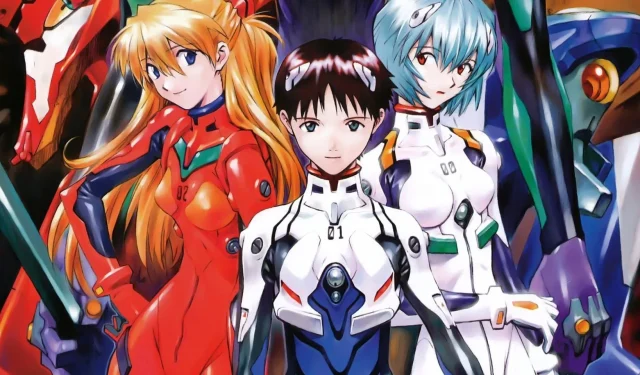Three decades since its launch on Japanese television in 1995, Neon Genesis Evangelion remains a titan in the anime landscape, renowned for its profound impact and lasting legacy. The franchise saw its official conclusion in 2021 with the release of the film Evangelion: 3.0+1.0 Thrice Upon a Time, yet it continues to resonate with fans old and new. Recently, Japan celebrated the series’ enduring popularity by erecting a striking six-meter-tall statue of Evangelion Unit-01 as part of a local tourism initiative. However, one element of the series has consistently puzzled audiences: its original television series ending.
In the climactic final episode, we witness Shinji Ikari’s poignant journey toward self-acceptance, where he acknowledges his self-loathing with the admission, “I hate myself. But maybe I can learn to love myself.” This internal struggle culminates in a transformative realization: “Maybe it’s okay for me to be here! That’s right! I’m me, nothing more, nothing less! I’m me. I want to be me! I want to be here! And it’s okay for me to be here!” The episode concludes with supportive figures surrounding Shinji, collectively proclaiming, “Congratulations!”
In stark contrast to the action-packed narrative filled with intricate mysteries leading towards an anticipated climax, the series’ introspective denouement left many viewers in shock. This unconventional finale raised numerous questions regarding the artistic vision of creator and director Hideaki Anno. Was this unexpected conclusion a conscious artistic statement, or merely a result of a tumultuous production process? What significance lay behind this unconventional ending? Recent insights from an unearthed interview with Anno shed light on these lingering uncertainties.
Anno’s Perspective: “I Never Wanted to Provide Answers”
A Narrative Anchored in Emotional Complexity
For many, the conclusion of Neon Genesis Evangelion felt jarring, abstract, and deeply personal—a stark diversion from the action-laden plot preceding it. However, Anno clarifies this choice was intentional. In a 2001 interview with NHK’s Top Runner, he stated, “My goal was never to provide answers or a sense of resolution.” He designed the series’ final episodes to convey an incomplete narrative, embracing ambiguity as a core element. “That ambiguity became part of the service I was providing,” he articulated, positioning the unfinished story not as a failure, but as an expression of genuine emotional experience.

Anno further elaborated that this fragmented, inward-looking conclusion mirrored his own mental struggles during production. He confessed, “I didn’t really understand myself or the world around me,” indicating that the confusion influencing the story was a reflection of his own emotional state. This approach prioritized an honest representation of inner conflict over neatly tied-up conclusions. “One of the services I could provide to the audience was to show that confusion,” he said, emphasizing that if viewers could relate to that sense of uncertainty, it rendered the experience worthwhile. Thus, the ending transcended plot explanation, aiming instead for an emotional resonance.
A Groundbreaking Legacy: Initial Reactions and Western Enthusiasm
Gradual American Release of Evangelion

As a 1990s anime enthusiast, I encountered the buzz surrounding Neon Genesis Evangelion long before actually watching it. The series had achieved remarkable success in Japan, and its influence was rippling through Western anime communities. Fans were eager to see what Hideaki Anno and Studio Gainax—already lauded for titles like Gunbuster and Nadia: The Secret of Blue Water—would deliver. Yet, it was the series’ final episodes that ignited fervent discussion. The unconventional conclusion captured headlines in prominent magazines and sparked debates online, leading fans to theorize about Anno’s intent or express their discontent.
ADV Films finally released Neon Genesis Evangelion in English in North America in 1997, nearly a year post its broadcast in Japan. I vividly recall the anticipation as the episodes rolled out on VHS tapes at a tantalizingly slow pace—only two episodes per month! As the final volume neared, excitement soared since overseas fans were acutely aware that the climax bore monumental implications. My friends and I made an effort to dodge spoilers during this pre-smartphone, pre-social media era, knowing only that the ending would be “weird,” based on whispers from Japan.
Audience Reactions: Shock, Analysis, and Controversy
The Rebuild Era: Enduring Mystique





The concluding moments of Episode 26 surprised me with their emotional weight, as characters stepped forward to applaud Shinji. My initial reaction echoed a common sentiment: “Is that really it? What just happened?” Fans in America shared similar sentiments to those in Japan, collectively feeling that this was far from the resolution we anticipated. Some viewers became fixated on dissecting the series, analyzing every line and nuance in pursuit of deeper meaning, while others dismissed the finale as indulgent or pretentious.
The outcry surrounding the conclusion prompted Hideaki Anno to revisit the narrative, resulting in The End of Evangelion released in 1997. This film reinterpreted the final episodes through a more grounded lens, delivering the epic spectacle that many fans believed was missing. While the film resolved some unanswered questions, it also ventured into even darker, surreal realms, reaffirming that “weird” was ingrained in the essence of Evangelion.
Years later, Anno orchestrated the Rebuild of Evangelion films, which began as an initial retelling but gradually evolved into a distinctive interpretation. While the visuals became more polished and the storyline expanded, the underlying ambiguity persisted. Reflecting on Anno’s earlier statements, “I didn’t really understand myself or the world around me,” one recognizes that this sense of confusion remains a constant within every iteration of Evangelion. Perhaps this is what captivates audiences—it’s a mystery meant to be felt, not solved.


